When people glimpse a juvenile iridescent shark (Pangasianodon hypophthalmus) in a fish store, they usually take in the flashing, shiny color and enormous eyes.
The blue tint of the skin looks stunning as the fish swim back and forth in a school. How could anyone resist?
But this freshwater shark species comes with a catch. As members of the Pangasiidae family, they share a lineage with the impressive Mekong giant catfish.

And those shiny juveniles? They have some LARGE fins to grow into – something they accomplish in a short period.
In no time at all, that blue-tinted fish from the store grows into a monstrous fish with dark skin – and the large eyes quickly become proportionate.
You still see a sail-like dorsal fin (it’s the feature that adds “shark” into their names), but now it’s on a MUCH bigger body.
The sheer size and the social needs of iridescent sharks make them a poor choice for home aquariums.
And the lack of adequate homework leads to these fish enduring poor conditions, health issues, and even change of ownership. So let’s make sure you know what you’re in for.
In this article
Iridescent Sharks At a Glance
| Tank size: | 300 gallons (1136 l) for ONE |
| School size: | at least 4 |
| Temperature: | 72-79°F (22-26°C) |
| Lifespan: | up to 20 years |
| Size: | 3-4 feet (0.9-1.2 m) |
| pH: | 6.5-7.5 |
| Hardness: | 2-20 dH |
| Ammonia: | 0 ppm |
| Nitrite: | 0 ppm |
| Nitrate: | <10 ppm |
In the Wild
Iridescent sharks concentrate in two river basins in Southeast Asia: the Mekong and the Chao Phraya.
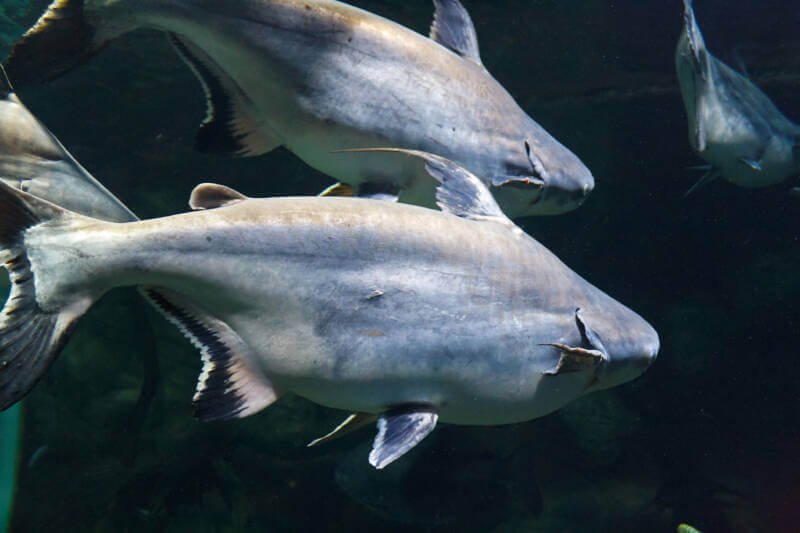
Both rivers provide the space these massive fish need to live, grow, and perform their reproductive migrations throughout different portions of the year.
In the rainy season, iridescents swim upstream to spawn. Then, as the weather dries out, they swim downstream to rear the fry.
They’re found in the deepest portions of the rivers (obviously), cruising in the middle of the water column.
Both juveniles and adults can raise or lower their dorsal and the top portion of their caudal fin.
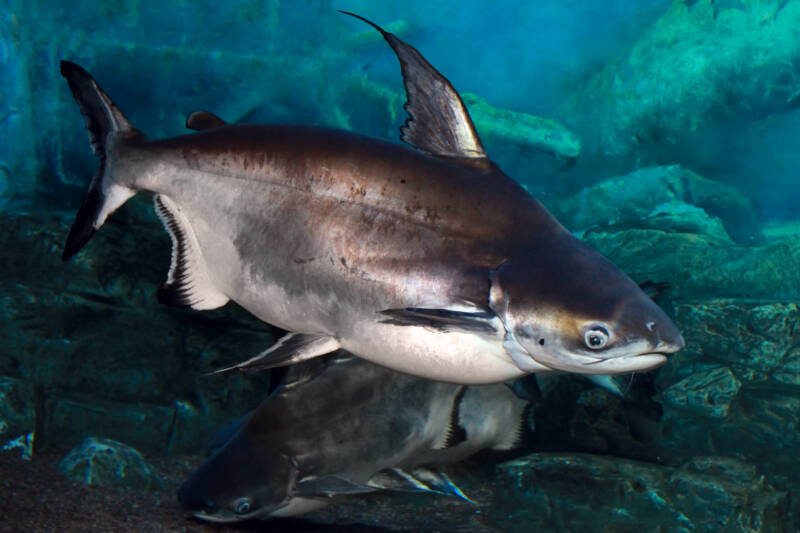
This allows them greater control while swimming and navigating the currents.
The long barbels (expected for a catfish) provide sensory data when visibility drops.
Most catfish species are nocturnal, emerging to hunt and forage during the evening hours.
But iridescents take the opposite routine. They’re diurnal in their habits. Even when the rainy season clouds the waters, those barbels provide them with the ability to “see” around them.
You’ll find them listed under a variety of different common names: iridescent shark, iridescent catfish, sutchi catfish, Siamese shark, or (if you’re looking on a menu) swai.
Due to their size and ease of “farming,” they feature as a popular dish throughout global cuisine. Unfortunately, that popularity – as a meal and an aquarium acquisition – has led to overexploitation.
Pollution along the river banks and dam installation further compromised their natural environment. And in 2011, they earned the status of endangered on the IUCN Red List.
That hasn’t stopped the aquarium trade, though. And while it’s rare, you CAN find albino iridescent sharks. Juveniles have a pink shade to their bodies – with a lack of stripes down their sides – and red eyes. As they mature, they turn into solid white adults.
Larger Than Advertised
In most fish stores, iridescent sharks get sold between 2.5 – 4 inches (6 – 10 cm).
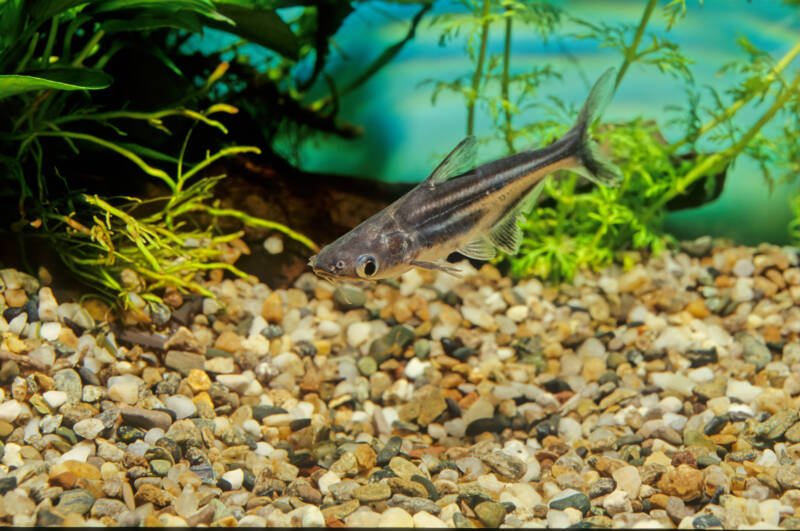
These juveniles sport a double black stripe around their lateral line. And they grow FAST. Within their first year, they top out around 12 inches (30.5 cm).
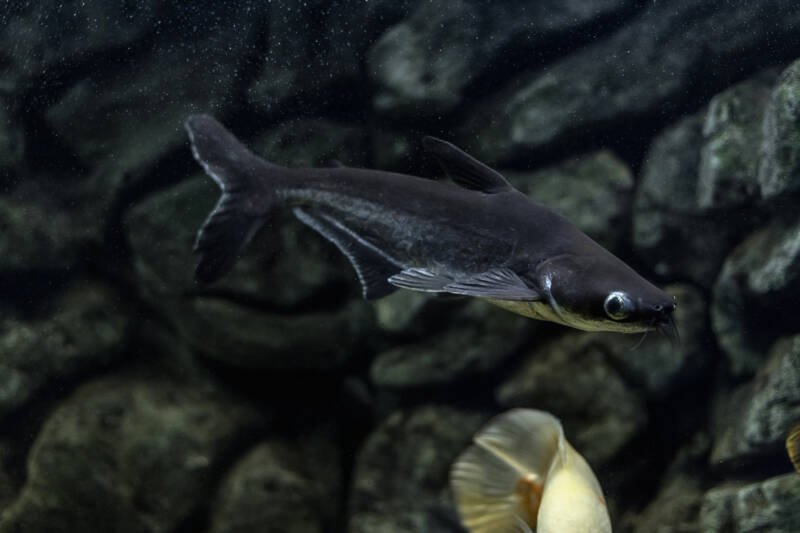
The problem then becomes keeping up with that growth. These massive fish reach a final size of around 3 – 4 feet (0.9-1.2 m)!

As they grow, the double stripe disappears, and they lose the blue tint that adds the iridescence to their name.
Lifespan
As if the massive size of the iridescent shark wasn’t troubling enough, this catfish can live for almost TWENTY years!
It makes taking on the species a particular commitment – in terms of space and time.
Unfortunately, most iridescent sharks don’t make it to their whole lifespan. A handful of years is closer to the usual expectation.
This is due to the lack of attention to their space and management needs, resulting in stressed and ill fish.
Behavior
While “shark” conjures images of a lone predator – and several freshwater sharks do best on their own – the iridescent shark is a schooling fish.
In a group, you calm down the natural nervous habits present in the species, preventing stress, leading to decreased health.
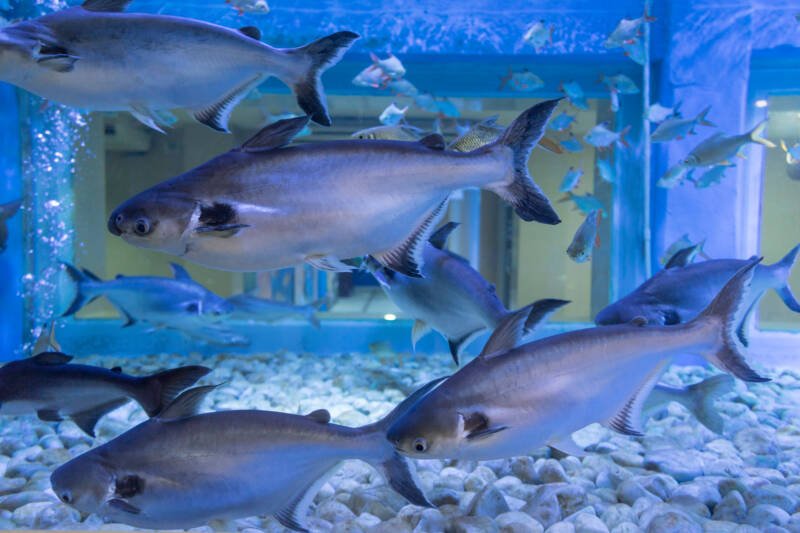
To ensure the comfort of your iridescent shark, you want to set up a shoal of at least four.
This will promote calm within your tank and encourage normal foraging and swimming behaviors. And since you’re dealing with LARGE catfish? Calm is the way to go.
A nervous, frightened iridescent will splash and even dart at the glass in panic. While it may LOOK aggressive, it’s a signal of stress.
And when you factor in the size and power behind your fish, it can also mean a potential problem for the tank’s integrity.
Iridescent sharks kept alone have jumped free of their tanks or even cracked the glass. Neither benefits the health of the fish, much less YOU.
Substituting a larger tank is NOT the answer. You need to keep this social species in the proper conditions.
Tank Setup
In the wild, iridescent sharks cover dramatic territories.
Throughout the daylight hours, they remain active swimmers. And you need to think of that when you plan for your tank size – not to mention how much room your adult catfish will need.
One iridescent shark needs 300 gallons (1136 l). But since it isn’t healthy to keep this species alone, you need to plan for more room than that.
Each additional shark needs 150 gallons (568 l). That can quickly add up to an aquarium beyond the scope of most hobbyists.
While you CAN start with your juveniles and plan to upgrade down the road, make sure you’re setting aside enough time. You don’t want your iridescents to end up squished and crowded while you’re ordering and preparing their new home. That will lead to stress.
Even with a shoal, this species startles easily. Therefore, you’ll want to minimize the amount of equipment INSIDE the tank.
Consider using an external or under gravel heater. That way, if something DOES spook your fish, they won’t slam into mechanics and injure themselves.
And since iridescent sharks (well, most catfish) are messy eaters, you need to invest in a quality filter.
Otherwise, you’ll end up with a filthy tank. Considering the size of the tank you’re looking at? Your best bet may be a canister filter.
Water Conditions
Iridescent sharks are tropical species. They need the water temperature to stay within the range of 72-79°F (22-26°C).
It doesn’t give you much room to play around. So make sure you have a thermometer to keep an eye on things.
As for their pH level, try to keep it neutral. Again, they have a narrow tolerance range: 6.5-7.5.
You have more room with your water hardness: 2-20 dH. Regular testing will ensure you’re staying within acceptable limits.
Iridescents DON’T tolerate ammonia or nitrates. That’s why your filter’s so essential.
Poor water quality will trigger a stress reaction and failing health. You can help with weekly water changes of 25% – something else to consider when you consider that tank size.
Decorating the Iridescent Tank
Now that you’ve dedicated a good portion of a room to the tank to hold your iridescent sharks, you want to make sure you don’t crowd it with décor or plants, taking away their swimming room.
They’re active fish, and you need to leave them open space.
But you also want to cut off their line of sight so they don’t panic whenever someone walks into the room. It’s a careful balance but easy to do when considering the natural habitat they encounter in southeast Asia.
Rather than choosing sand or gravel, choose aquatic soil. The rivers have muddy bottoms thick with silt.
You can then add pieces of driftwood or large rocks to replicate the average riverbed. (There’s no need to provide caves large enough for iridescent sharks to hide in)
You don’t find heavy vegetation in their native environment. And tall plant growth will interfere with their swimming room.
But floating plants can cut down on the glare from the lights, as well as creating some soundproofing:
- Amazon frogbit
- Anacharis
- Azolla
- Brazilian pennywort
- Cabomba
- Duckweed
- Dwarf water lettuce
- Floating bladderwort
- Hornwort
- Java moss
- Ludwigia repens
- Red root floater
- Riccia fluitans
- Rotala indica
- Water spangles
- Water sprite
- Water wisteria.
Iridescent Sharks in Communities

For most aquarists, managing a school of iridescent sharks is challenging enough. But these peaceful catfish do nicely in communities.
And if you’re going to spring for an impressive aquarium? Why not go for a colorful display?
Tank Mates
Iridescent sharks do well with fish their size. That can make you cringe (you’re already contemplating THOUSANDS of gallons/liters), but if you go small?
Your catfish might think those fish are snacks. So you need to add fish that can “bump shoulders” without a problem:
- Bichir
- Black shark
- Fire eel
- Imperial flower loach
- Kissing gourami
- Oscar
- Pantano cichlid
- Plecostomus
- Salvin’s cichlid
- Silver dollars
- Synodontis catfish
- Texas cichlid
- Tinfoil barbs.
You DO need to exercise some caution. Cichlids have the most bulk, but as you increase their size, they usually come with aggression.

And iridescents don’t know how to defend themselves. Instead, they’ll flee – which you already know can turn disastrous.
Monitor everyone for the first few weeks to make sure they’re behaving themselves. And have a plan B in case you need to rehome one of the fish.
Incompatible Species
As cute as smaller fish (like tetras and barbs) swimming around an enormous catfish might SEEM, you’re risking those little guys getting swallowed by your iridescent shark.
It isn’t a mean streak – they simply assume you added something new to the menu.
Along the same lines, skip crustaceans. Your shrimp will disappear, even if you’re keeping up with a healthy diet. That means you’ll need to skip over snails, too.
Mixed aquariums don’t do well with these gentle giants.
Feeding Iridescent Sharks
As omnivores (not to mention members of the catfish group), iridescent sharks aren’t picky eaters. However, you still want to do some homework and apply thought to keep these fish happy and healthy.
The age of your iridescent sharks determines the focus of their diet.
As juveniles, iridescents focus more on protein. This is because they still have teeth.
So you’ll want to focus on live, frozen, or freeze-dried versions to boost their growth (not to mention those shining scales):
- Bloodworms
- Brine shrimp
- Feeder fish
- Worms.
As the sharks mature, their teeth start falling out. (Not through anything you’re doing wrong – it’s a natural process)
And they begin to incorporate more plant material into their diet. You still want to keep the protein up, but now it’s okay to boost the algae ingredients.
You want to focus on the quality of whatever food options you choose. Nutrient deficiencies often shorten the lifespan of iridescent sharks.
You may need to supplement with vitamins to make sure your iridescent sharks remain healthy.
Breeding Iridescent Sharks: A Wild Proposition
While tackling the breeding of iridescent sharks sounds thrilling and challenging, you’re going to need to set that ambition aside.
This isn’t a task that’s possible within the captive environment. And, yes, it comes down to the problem of tank size again.
In the wild, these catfish migrate to spawning regions on the rivers. Unfortunately, it’s impossible to recreate that ability in a home aquarium.
And without the triggers of that travel, their bodies don’t receive the proper signals to produce gametes.
Male or Female?
However, if you’re curious about whether you have males or females swimming in your iridescent shark school, you CAN manage that. As with everything else with this catfish species, size is the biggest clue.
Male iridescent sharks have a more streamlined silhouette, appearing narrower when you look down on them from above.
Females are wider and don’t have the same sleek shape. And this applies even without breeding triggers.
Health and Diseases
Iridescent sharks don’t possess scales. So that bumps them higher on the risk for ANY skin condition, include ich.
And since stress predisposes a fish to ich due to the lowered immune defense, it’s not a surprise to find these catfish covered in the parasite.
Luckily, the dark coloration of the skin (unless you have an albino variety) makes it easy to pick out the white spots. And these fish respond to treatment well – provided you deal with the source of the stress that led to the problem in the first place.
That’s one of the biggest problems with iridescent sharks. Stress spikes adrenaline, boosting the body’s stress hormones, which strains the fish’s system.
If they don’t feel comfortable (for instance, if kept alone), the strain leads to repetitive illness and a reduced lifespan.
Iridescent Sharks: Are They For You?
As most people purchase iridescent sharks as juveniles, you’ll find them running anywhere from $15-$100.
Of course, that doesn’t take into account the tank you’ll need or any of the ancillary equipment to support the school.
These catfish are famous for their color and shape, but they’re not practical for the average hobbyist. The space demands alone relegate them to the commercial industry.
It simply isn’t fair to keep an iridescent shark – a social species – alone and stressed.
Even worse, you shouldn’t attempt to cram one of these massive fish into a too-small aquarium.
The risk of injury to the shark (or you, if they happen to damage the glass) is too high. You’re better off selecting a smaller species.
The Unexpected Silver Giant
Iridescent sharks look stunning and manageable – as juveniles. But within a year or two, they often outgrow the ability of most people to house and care for them.
If you aspire to bring this catfish home, ensure you’re prepared to handle the needs of the entire school.
Do you keep iridescent sharks? How large is the tank you use?
Are they a single-species tank or a community?
Let us know your questions or stories here!